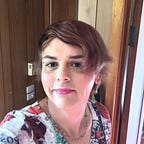D is for Difference, Different, Diverse, Divergent…
Spend any amount of time around the autistic community and the wider neurodiversity movement and you will undoubtedly hear someone say, likely in exact words, but possibly paraphrased or eluded to the words:
Different Not Less!
It’s a catchcry, an anthem, a statement, an idea, a rallying cry. An article of faith.
But it’s more. It is a truth.
Across society, in school, in training, in colleges, in motivational speeches we hear it a lot. Don’t be ordinary, be different, stand out from the crowd, let your light shine. There are many metaphors or idioms that convey the message. The message to not be like everyone else but to be the very best you can be. Be all you possibly can be.
Funnily enough, that message is Be Different.
I guess they don’t mean neuro-different. Just different that fits a particular viewpoint of what different might mean.
Newsflash: Everyone is different and it does not make them any less a human person.
This world we inhabit is full of mixed messages and contradiction. In many parts of the world, on the one hand, is the message to stand out from the crowd whilst at the same time we push ourselves and each other through a sausage machine of sameness. Primary School, High School, University, Work.
That’s the right of passage to humanity apparently.
It is widely believed in the scientific community that autism is a genetic difference. Whether this difference is pre-conception or begins sometime during a pregnancy is not established. So an autistic child is born just like a non-autistic child but guess what we’re just a little bit different.
Yes, a little bit different but not any bit less.
In the years after Autism was being described and in its infancy of understanding a man by the name of Ivaar Lovaas came up with a behavioural therapy, the goal of this therapy was and remains, to eradicate the visible difference between the autistic and the allistic child. Autistics in his view were not, in fact, humans but sub-type human. In effect some kind of empty shells
that needed to be somehow filled with humanity in order to be completed. I would suggest you read Steve Silberman’s excellent work Neurotribes to flesh this out.
The different not less cry continues to be needed because of such beliefs and the prevalence of such therapies.
Different, difference, divergence is a good thing.
Imagine we didn’t have different thinkers. Would we even have science? Would we have Trigonometry, Music, Pythagoras?
I have no idea if Einstein was really autistic. Many say yes, some say no. But what is certain is that he was indeed different. He certainly did not fit into the everyday mould of what was considered to be normal and typical.
Autistic and otherly neurodivergent people are and have always been present in our society, they always will be.
Imagine no Mozart. Now that would leave us less.
Without difference humanity would certainly be less.
D is for difference. And dare I say it humanity must learn to embrace it.
D is for difference. Yes, I am different, and damn it I am glad!
One thing that I have observed quite a bit around the autism parent community is a tendency to say things along the lines of I love him, he is just different. She is not less she is my supergirl. This is a great thing, however, at the same time many of those that make such claims are still at the same time determined to remove particular behaviours, teach particular social rules to be followed and engage in compliance training. The question I have on this, is, if you truly do embrace difference then why does the child need to be changed?
D is for difference and if we truly embrace difference then we would seek to understand why autistics stim rather than attempting to remove that behaviour. To understand why I don’t look you in the eye and acknowledge the truth that it doesn’t mean I am not listening or I am to be treated with suspicion.
D is for difference. Embrace it.
Different Not Less.
